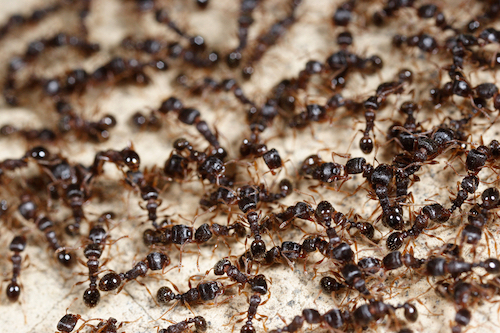READY TO GET STARTED?
REQUEST A FREE ESTIMATE
Fill out the form below or call (888) 466-7849 for a free, no-obligation estimate.

Millipedes, also known as “thousand leggers,” are arthropods that often make their way into our homes. Millipedes range from 2.5 to 4 cm long, are brownish in color, are long and slender, and look a lot like worms with legs. They are segmented with 2 pairs of legs per segment. Millipedes are nocturnal and tend to move in large numbers. They are also scavengers, feeding on decaying plant material in and around your home. While they are definitely creepy looking, they don’t bite or cause any damage to your home or food supplies.
Millipedes are often found outdoors in damp places such as mulch, flowerbeds, under leaves, compost, rotting wood, and under stones in your yard. They are also commonly found around foundations. Excess rain, drought, and cooler temperatures can make their outdoor habitats less favorable for them and you will often see millipedes in the house during these conditions. Excess rain will drive them indoors in search of shelter and drought will drive them indoors in search of water. Once in your home, they tend to gravitate toward damp areas such as laundry rooms, basements, and crawlspaces. Millipedes will usually die fairly quickly once they get inside due to the lack of moisture. If you’re wondering how to get rid of millipedes indoors, you can simply remove them with a vacuum cleaner or shop-vac.
How can you prevent a millipede infestation from taking over your home? Here are a few tips to prevent millipedes in the house.
What to Expect When Signing Up for Termite Protection
Lawn Care: What’s Causing Yellow Spots on Your Lawn & How to Fix It

Summer and rain usually mean humidity and a potentially bad hair day, but it may also come with some creepy crawlies. Rain tends to flood pests out of their hiding spaces outside, and they will seek refuge in places within your home that still have high moisture (a huge necessity for their survival). One of the pests that heavily relies on an abundance of moisture is the millipede.
Here are some facts about this many-legged pest and some tips to keep them out:

You may be wondering what options you have to help keep your home free of these tiny crawlers. The most effective method is investing in Green Pest Control, which can help with a variety of pests the rain and summer may bring, including millipedes. You can also prevent millipedes and other pests by installing Leafproof Gutter Guard, which keeps your gutters clean of debris, allowing for proper drainage and keeping pests away from your home.
If you have a millipede infestation or general pest questions, contact your local pest control company or fill out the form below to request a free pest inspection.

With pollen season in full swing, the rain is more than welcome in order to get some relief. However, when the rain has decided to overstay its welcome, it can lead to unwelcome visitors in your home and pests that overtake your yard.

Spiders/Ants/Roaches – Once their shelter is compromised, these pests will seek refuge in homes, gaining access through small cracks that lead from the exterior of your home. Once these pests find that your home provides an excellent food source and shelter from the outside, they will attempt to establish a permanent residence.
Mosquitoes – Excessive rain leads to more sites of standing water that are perfect for mosquitoes to use for breeding, leading to mosquitoes progressively taking over your yard.
Millipedes/Earwigs/Silverfish/Crickets – These pests thrive outside as their main source of food is decaying vegetation. While they like moisture, excess rain will push them out of their hiding spots, and the high levels of moisture in your basement will be an appealing new home.
You can take the following steps to make sure these unwanted guests stop invading your home:

With pollen season in full swing, the rain is more than welcome in order to get some relief. However, when the rain has decided to overstay its welcome, it can lead to unwelcome visitors in your home and pests that overtake your yard.

Spiders/Ants/Roaches – Once their shelter is compromised, these pests will seek refuge in homes, gaining access through small cracks that lead from the exterior of your home. Once these pests find that your home provides an excellent food source and shelter from the outside, they will attempt to establish a permanent residence.
Mosquitoes – Excessive rain leads to more sites of standing water that are perfect for mosquitoes to use for breeding, leading to mosquitoes progressively taking over your yard.
Millipedes/Earwigs/Silverfish/Crickets – These pests thrive outside as their main source of food is decaying vegetation. While they like moisture, excess rain will push them out of their hiding spots, and the high levels of moisture in your basement will be an appealing new home.
You can take the following steps to make sure these unwanted guests stop invading your home:





